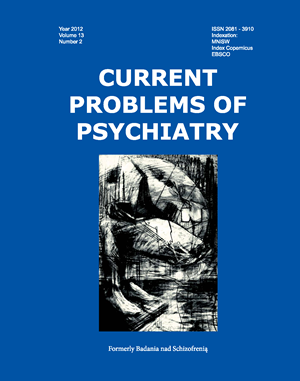Symptoms of mobile phone addiction and adolescents' use of online social networking sites
Keywords:
online social networking sites, mobile phone addiction, genderAbstract
The aim of the study was to answer the following research problems:
- whether and what differences exist between individuals at risk and those not at risk of addiction to mobile phone in terms of time spent on “Nasza Klasa” website?
- whether and what relationships exist between time spent on the social network "Nasza Klasa" by young people and the severity of addiction to mobile phone?
- whether and what relationships exist between the symptoms of addiction to mobile phone and activity of young people on “Nasza Klasa” profile, and reasons of having profile on this social network?
Material and methods. The research group consisted of 291 junior high and secondary school students. The following methods were used in this study: the Survey form and the Mobile Phone Addiction Assessment Questionnaire by Pawłowska and Potembska.
Results and conclusions.
More girls than boys have a profile on the social network “Nasza Klasa” and meet criteria of dependence and risk of addiction to mobile phone.
The main motivation for the youth to have a profile on the social network “Nasza Klasa” is desire to: maintain in touch with friends, get information about friends, brag. On this social network zoung people comment on photos posted by other users, post their travel photos, family pictures and pictures from family celebrations.
The more time girls spend on using social networking sites, the more severe their mobile phone addiction symptoms are.
Intense symptoms of addiction to phone calls and text messages, preference for communicating by mobile phone to "face to face" meeting, looking for acceptance and closeness in relationships established via mobile phone co-occur with increased time spent on using the social network “Nasza Klasa” and need of bragging.
References
1. Doroszewicz K. Aktywne porozumiewanie się. W: Skrzyński W., Dyrda M. (red.), Wykłady z psychologii społecznej. 2003, s. 167-192.
2. Ross C., Orr E.S., Sisic M., Arseneault J.M., Simmering M.G., Orr R.R. Personality and motivations associated with Facebook use. Comp. Hum. Behav., 2009; 25: 578-586.
3. Barkhuus L, Tashiro J. Student Socialization in the Age of Facebook. CHI 2010: ACM Press; 2010, pp. 133-142.
4. Humphreys L. Mobile Social Networks and Social Practice: A Case Study of Dodgeball. J. Comput. Mediat. Commun., 2008; 13: 341-360.
5. Lampe, C., Ellison, N. and Steinfield, C. A Face(book) in the Crowd: Social Searching vs. Social Browsing. In proceedings of ACM Special Interest Group on Computer-Supported Cooperative Work, ACM Press: 2006, pp. 167-170.
6. Sheldon K.M., Abad N., Hinsch C. (2011, January 31). A Two-Process View of Facebook Use and Relatedness Need-Satisfaction: Disconnection Drives Use, and Connection Rewards It. Journal of Personality and Social Psychology. Advance online publication. doi: 10.1037/a0022407.
7. Pawłowska B., Potembska E. Gender and severity of symptoms of mobile phone addiction in Polish gymnasium, secondary school and university students. Curr. Probl. Psychiatry, 2011; 12(4): 433-438.
8. Pawłowska B., Potembska E. Właściwości psychometryczne Kwestionariusza do Badania Uzależnienia od Internetu (KBUI). Bad. Schizofr., 2009; 10: 310-321.
9. Potembska E, Pawłowska B. Właściwości psychometryczne Kwestionariusza do Badania Uzależnienia od Telefonu Komórkowego (KBUTK). Bad. Schizofr., 2009; 10: 322-329.
10. Pawłowska B., Potembska E. Objawy zagrożenia uzależnieniem i uzależnienia od telefonu komórkowego mierzonego Kwestionariuszem do Badania Uzależnienia od Telefonu Komórkowego, autorstwa Potembskiej i Pawłowskiej u młodzieży polskiej w wieku od 13 do 24 lat. Curr. Probl. Psychiatry, 2011; 12(4): 443-446.
11. Igarashi T., Takai J., Yoshida T. Gender Differences in Social Network Development via Mobile Phone Text Messages: A Longitudinal Study. J. Soc. Pers. Relat., 2005; 22(5): 691-713.
12. Doring N., Hellwig K., Klimsa P. Mobile communication among German youth. Nyiri K. Ed., A sense of place: The global and the local in mobile communication., Vienna; Austria: Passagen Verlag, 2005, pp. 209-217.


